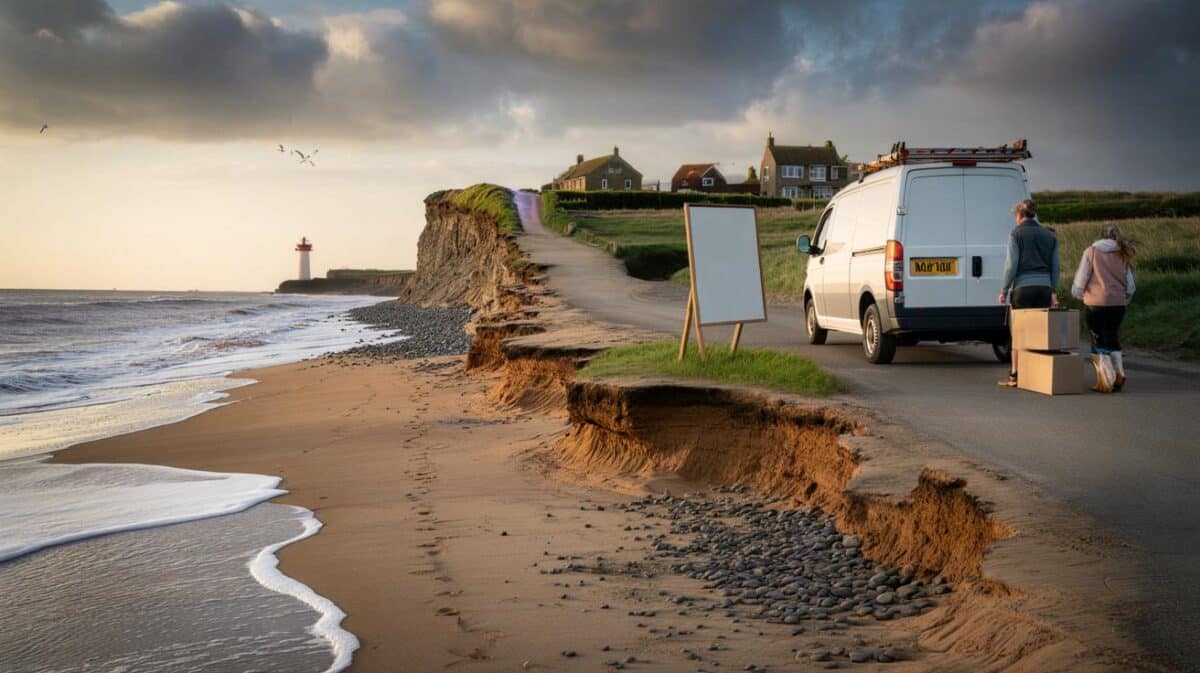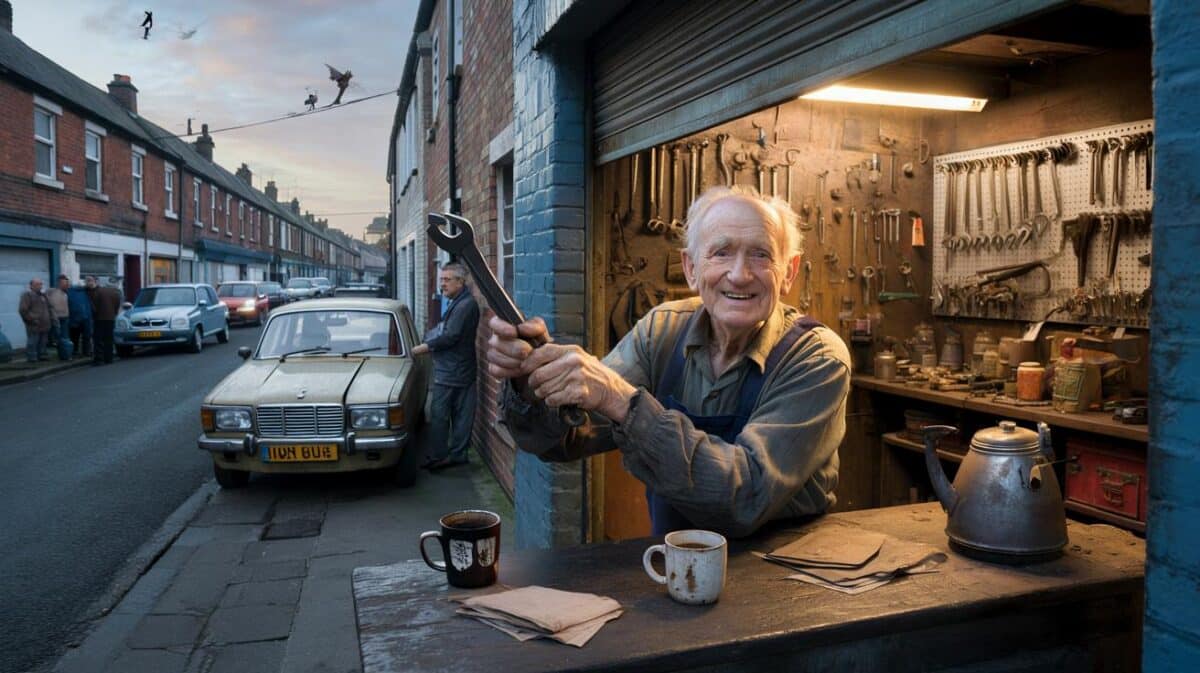Then a polite-but-pointed email landed: the village’s brand-new Christmas lights can’t be taken down in January unless the England flags strung across the street come down first. Pride meets policy. Tinsel meets red crosses. And a simple winter switch-off turns into a small-town standoff.
It’s late afternoon and the lampposts are already glowing, throwing warm puddles of light onto damp cobbles. A pair of kids press noses to a frosted window, counting reindeer bulbs. Outside the corner shop, neighbours swap glances at the parish noticeboard, where a laminated sheet spells it out: “Removal of new festive lighting requires clear access. Flags must be taken down.” You can hear the sighs. One man calls it madness. Another shrugs and mutters about insurance and ladders. A string of red-and-white crosses flaps above, snagged on a wire like they’re making a point. The contractor’s van idles on the green. The engine doesn’t cough. It purrs, waiting. Something’s got to give.
When festive glow meets flag pride
Walk the high street and you’ll see it straightaway: wires on wires, motifs on brackets, bunting looping from pub to post. The new LEDs are crisp and bright, strung higher than last year, with fresh fixings and heavier cabling. The England flags, some faded from a wet summer, hang stubborn and cheery. Nothing dangerous at a glance. Yet the lines cross in three places, and one bracket is buried behind fluttering fabric. Safety sets the rhythm now. The lights can’t be safely lowered, the contractor says, if flags keep brushing the rigging. A tiny knot in a big season.
At the bakery, the owner points to the gutter where two cables kiss. She remembers the night the lights went on, a Friday crowd, phones held high, a dog barking at the sparkle. Earlier that week, a volunteer had climbed a short ladder to gently lift a flag over a bracket. The flag fell back the next windy day. “No harm done,” she thought. Then came the memo about access routes for cherry pickers, turning circles, and a warning that any obstruction could void cover. The room went quiet. The sausage rolls kept selling. The flags kept waving.
Rules for street kit are more rigid than people think. Lampposts aren’t just posts; they’re regulated assets with load limits and fixed points for add-ons. Contractors follow method statements signed off by insurers. If a line is snagged, if a strap is hidden, if windage can’t be predicted, the job stops. There’s also the optics. A council can’t be seen to pick favourites between symbols, so it sticks to neat phrases like “clear spans” and “free access”. No drama. Just protocols. And a small cultural breeze blowing through every bracket in the village.
The neat fix nobody loves but everyone can live with
There’s a simple way through: agree a 48-hour window, lift the flags, drop the lights, then rehang everything cleanly. That means a map of where each span crosses, a list of house-front fixings, and two stepladders stationed with gaffer tape and gloves. One steward at each end of the street for a half hour, just while the truck is up. The contractor does the careful part: lowering each motif into a safe zone, checking bolts, and coiling cabling. Flags go back on fresh hooks, a finger’s width lower than the brackets. No drama. Just a tidy rhythm to end the season.
The trap most places fall into is leaving it all to the last frosty week. People are busy, the WhatsApp pings get ignored, and DIY fixes drift higher than they should. Let’s be honest: nobody really does that every day. If you’re flying a flag on a shared span, mark it with a ribbon so it’s easy to spot from the ground. Keep line joins visible, not behind flapping fabric. And if your heart says “Not my flag,” try a neighbourly compromise. We’ve all had that moment when a small rule collides with a big feeling.
The real win is getting everyone to the same five-minute briefing. As one lighting contractor told me on the green,
“Give me clear spans, ten minutes without wind, and two people who know which rope is which. I’ll give you a clean takedown — no drama, no headlines.”
Put that on a fridge magnet if you must. And stick this mini-checklist on the noticeboard too:
- Pick a weather window under 20 mph wind.
- Tag every span with coloured tape: flags one colour, lights another.
- Agree a 30-minute road watch with hi-vis and a whistle.
- Lower lights first, then rehang flags with a clear offset.
- Photograph fixings for next year’s plan.
Beyond one street: why this tiny row matters
In a small place, the wires above your head quietly tell you who’s talking to whom. A flag says home and pride. A reindeer says season and togetherness. When they share the same span, they share the same rulebook. That doesn’t cancel anyone out. It nudges everyone in. The trick is to keep the language practical, not tribal. You’re not removing a symbol; you’re clearing a line so the village can follow its own traditions without a nasty fall or a lost claim. That’s how you keep warmth and common sense on the same street.
Here’s the blunt bit: a council can’t cave to passion and ignore paperwork. Insurers won’t. Engineers won’t. So the kinder move, oddly, is the tidy one. Clear spans. Lower winches. Fresh hooks. Then put the flags back, maybe a palm lower, maybe on separate cords fixed to brick instead of cables. Pride doesn’t fade if you move it six inches. It often looks better. And the Christmas lights won’t wobble into January because everyone waited too long to make a plan.
What happens next will travel. Neighbouring villages will borrow the playbook. Contractors will add a “flag note” to their method statements. The parish will file photos so next November runs smoother. A row that began with a paper notice might end with something rare: a seasonal ritual that respects both safety and sentiment. Not a grand compromise; a humane one. A better way to hang the things we care about, without tripping over the things that keep us safe.
What lingers is the image of that street at dusk, glow on wet stone, a faint smell of woodsmoke, the light hum of a generator down by the hall. People will argue about flags and rules forever. That’s fine. It means they care. The test is whether a village finds a pace that fits both the book and the heart. Lift, lower, rehang. Tea after. Stories told. Tiny adjustments that keep the peace without dimming the magic. A neat, almost invisible choreography. And a small lesson about how communities bend without breaking.
| Key points | Detail | Interest for the reader |
|---|---|---|
| Safety first on shared spans | Flags can snag lighting brackets and cabling during removal | Explains the “why” behind a frustrating rule |
| A quick, planned window works | 48-hour flag lift, light takedown, then clean rehang | Gives a practical pathway, not just opinion |
| Keep pride and protocol | Offset fixings, photos for next year, light-touch stewarding | Shows how to protect symbols and keep the lights |
FAQ :
- Why can’t the contractor just work around the flags?Because method statements and insurance require clear access to fixings and cables. If a span is obscured, the job pauses.
- Is this about banning England flags?No. It’s about clearance on shared lines. Flags can go back once the lights are down or adjusted.
- Can residents take lights down themselves?Not advised on public assets. Lampposts have load limits and live feeds. Leave it to accredited crews.
- What’s the fastest fix?Agree a short time window, tag lines by colour, and create a safe, wind-light slot for the contractor.
- Could the village avoid this next year?Yes. Separate fixings for flags, documented offsets, and a pre-season check with the contractor.









